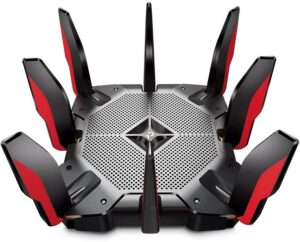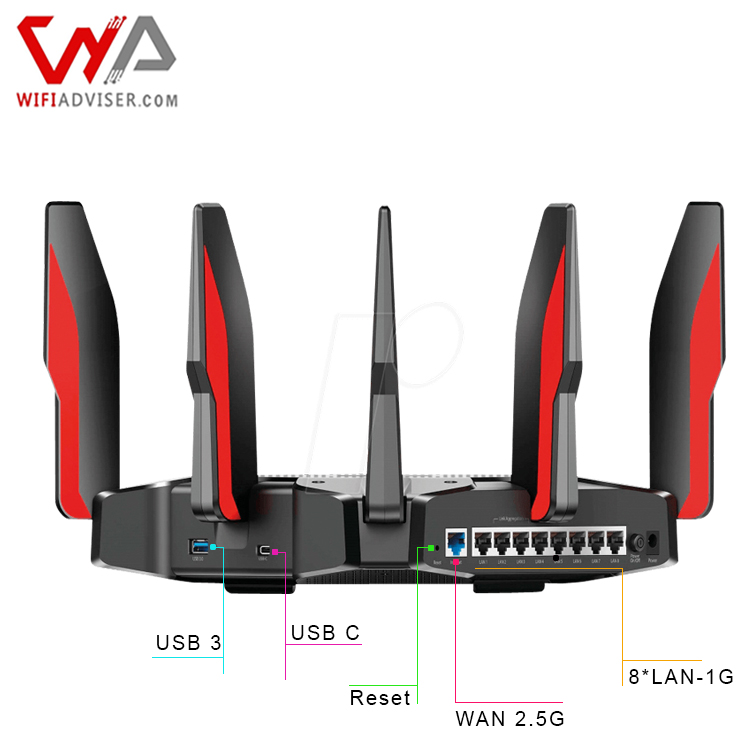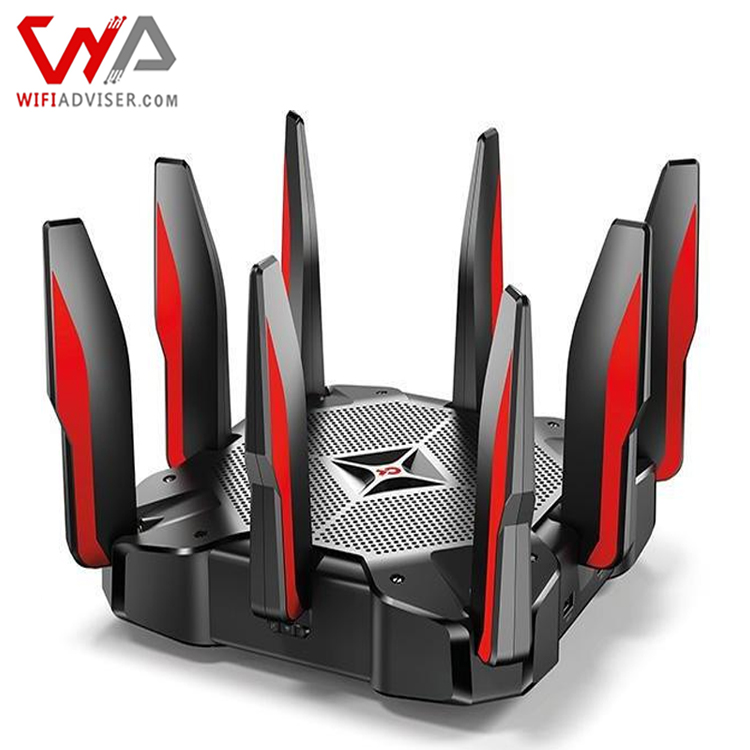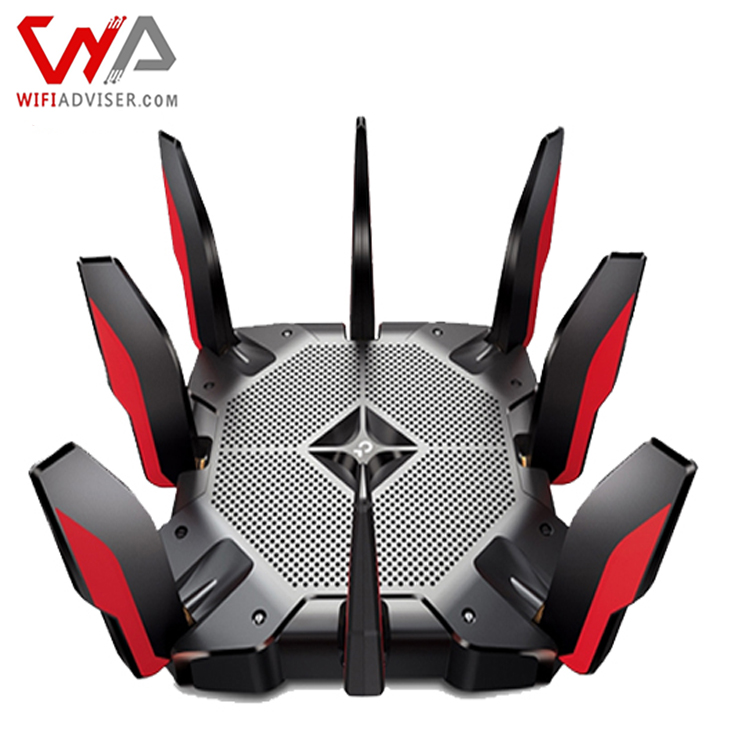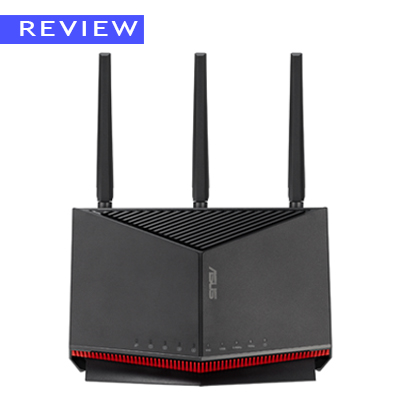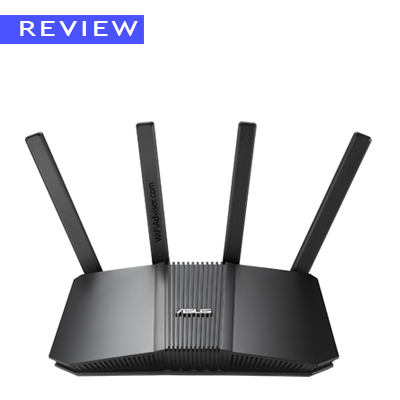Introduction
Are you tired of buffering continuously laggy streams, and loose gameplay? It’s time to replace your old router with a new one, like TP-Link Archer AX11000 to fully utilize your internet connection. This powerful router isn’t just another network upgrade; it’s a gaming gateway made to eliminate latency, solve lag, and help you win.
However, does the TPLink AX11000 actually offer the best gaming experience? As we examine this beast’s features, performance, and ability to turn your home network into a gaming network, fasten your seatbelts.
This review focuses on the experience rather than just the specifications. We’ll test the Archer AX11000 and examine how well it performs in real-world gaming situations. In order to assist you in determining whether it is the best tool for your gaming equipment, we will also look at its value for money, customization possibilities, and ease of use.
Archer AX11000 Unboxing: Built for Domination
The Archer AX11000 comes in a heavy box that suggests the power it has. When you pull it out, the sleek, angular form (those antennae, really!) looks like space equipment. It has weight and demonstrates performance and stability.
But let’s get into the details of what makes this router tick. Beyond the striking design, the AX11000 boasts some serious hardware:
- Powerful Processing: At its core is a 1.8 GHz quad-core processor, supported by three co-processors and 1GB of RAM. This processing power is crucial for handling the demands of multiple devices, high-bandwidth activities, and advanced features. This is also what enables the router to maintain smooth, lag-free performance even when the network is under heavy load with many devices streaming, downloading, and gaming online.
- Ports: The rear of the router features eight 1Gbps LAN ports, ready to connect all of your wired devices, including your NAS and gaming consoles. Also, the presence of a 2.5 Gigabit WAN port allows connection with the fastest internet providers and brings the highest possible speed for those with multi-gig internet plans. This is a key feature for future-proofing your network.
- USB Connectivity: On the side, you’ll find two USB 3.0 ports (one Type-A and one Type-C) for flexible connectivity. Connect a USB storage device or a hard drive to distribute files throughout the network, share media, or even create a Time Machine backup.
- Antenna Design: The AX11000 is equipped with eight external antennas. Competitor reviews note that these antennas, while not adjustable, offer a very secure and firm connection to the router.
- LEDs and Controls: The router includes an array of LEDs to indicate network status and activity. Additionally, it has physical buttons for controlling various functions, such as turning the Wi-Fi and LEDs on/off, and a WPS button for quick connections.
Discover the engine powering this beast by lifting the hood: a 1.8 GHz quad-core CPU backed by three coprocessors and 1GB of RAM. This results in seamless, lag-free performance even when numerous devices are streaming, downloading, and battling online and overloading your network.
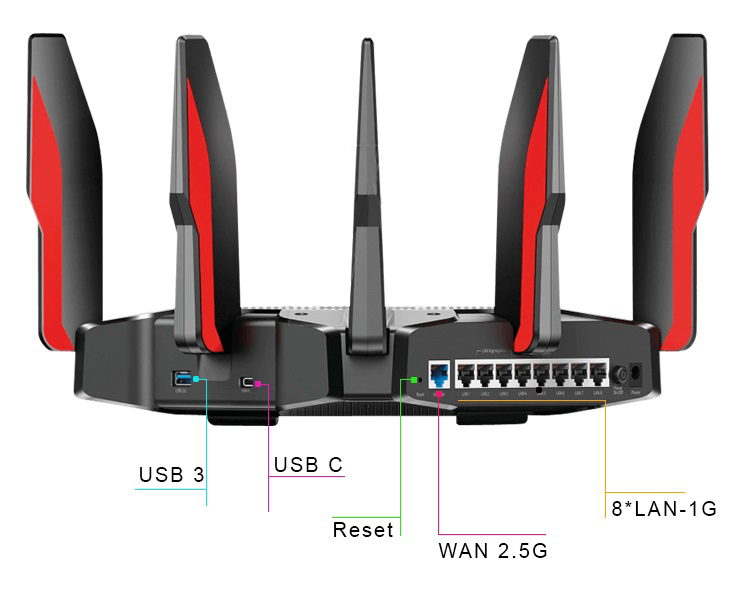

The TP-Link Archer AX11000’s rear panel, showcasing its comprehensive wired connectivity options, including Gigabit Ethernet LAN ports and a 2.5Gbps WAN port.
Stay tuned for our comprehensive review, in which we’ll test the TPLink Archer AX11000 and determine whether it really offers the best gaming network experience. On the surface, however, it appears that this router is really powerful. The TPLink AX11000 may be your ideal endgame router if you’re a serious gamer who requires steady performance, security, and customization.
Gaming: Can This Router Make You a Pro Gamer?
TP-Link advertises the Archer AX11000 as a special “gaming router.” This means they say it’s excellent for playing games online. It’s definitely a very strong router, which is important for gaming. It can move a lot of data very fast, and it can handle many players at the same time. But are its special “gaming” features truly useful? Let’s investigate.
- Game Accelerator: Minimizing Lag
TP-Link’s “Game Accelerator” aims to reduce lag, the delay between your actions and the game’s response. Lower lag is crucial for fast-paced games. TP-Link suggests this feature can cut lag by around 20% to 30%.
- Game Protector: Securing and Controlling Your Game
Includes antivirus and parental controls, both valuable for gamers:
- Antivirus: Protects your gaming devices and network from malware and cyber threats, ensuring a safe and uninterrupted gaming experience.
- Parental Controls: Help manage screen time and filter content, especially important for younger gamers in the household, allowing for a balanced lifestyle.
- Game Statistics: Monitoring Your Connection
Provides insights into network traffic, which can be useful for:
- Identifying bottlenecks: Pinpointing devices or applications consuming excessive bandwidth and causing lag.
- Prioritizing game traffic: Ensuring your game receives the necessary bandwidth for optimal performance.
- Troubleshooting: Diagnosing network issues that may be affecting your gaming experience.
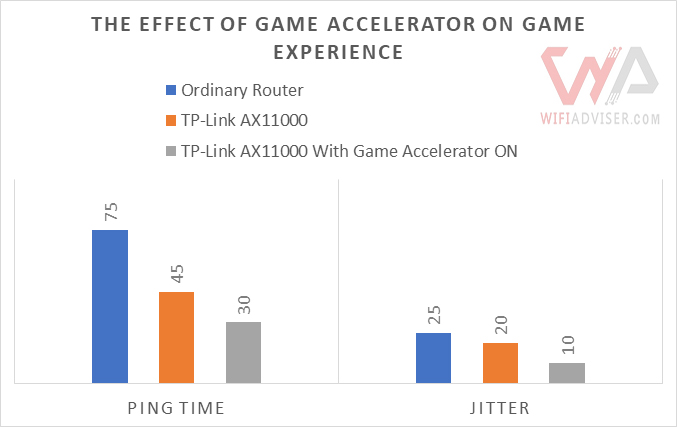

Ping and Jitter Comparison: Ordinary Router vs. TP-Link AX11000 with/without Game Accelerator.
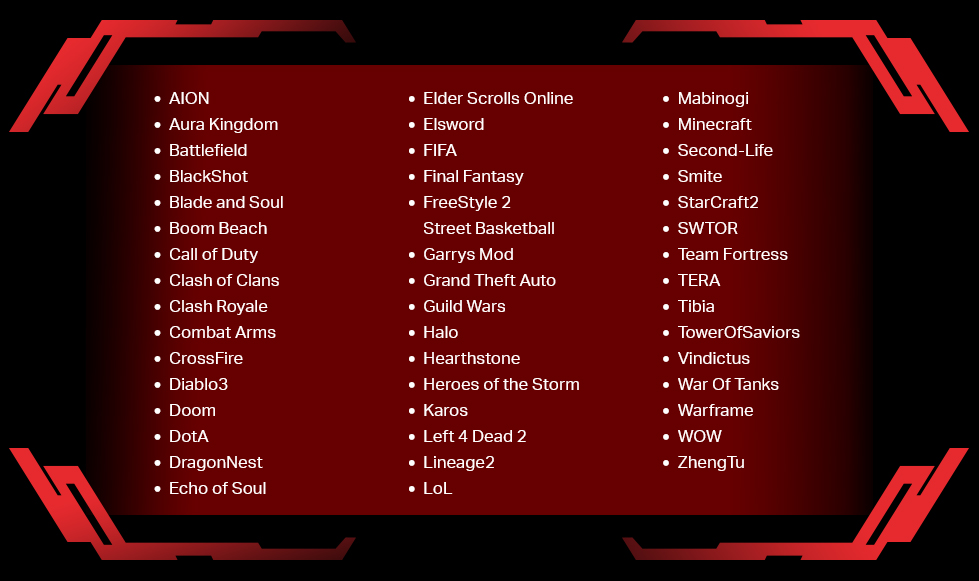

Popular Online Games That Benefit From the Archer AX11000’s Features
Gaming Performance with Tri-Band Support
Imagine yourself in the middle of a online battle, laser beams shining, when suddenly… lag. The world collapses, and your hero freezes. Nightmares, right? The TPLink Archer AX11000, as a professional gaming router, eliminates such problems.
Three frequency bands are supported simultaneously by this router: 2.4 GHz, 5 GHz, and 5 GHz gaming. You may communicate with a variety of devices concurrently in different frequency bands with the TPLink AX11000, So, you can enjoy the highest possible speed. For instance, your smart TV, game console, and cell phone are all connected to different bands.
- The 2.4GHz band: With up to 574Mbps, handles essential tasks like web browsing and email with ease, even on older equipment.
- The 5GHz band is really quick! With its amazing 4804Mbps speed, you may download files for your laptop or PC in seconds rather than minutes.
- The ultimate weapon is the 5GHz gaming band, which has a unique characteristics and a speed of 4804Mbps. It prioritizes your gaming traffic using Game Accelerator, so you can play smoothly even as your family is watching 4K movies in another room.
A stronger signal can be delivered to clients in blind spots by adjusting the antenna’s angle, guaranteeing that everyone enjoys the same share of the internet. All users and devices on the network can communicate more effectively thanks to this number of antennas, which can handle up to four devices at once (4*4 MU-MIMO).
The performance in my tests was really amazing. Streaming was perfect, games loaded quickly, and this router was unaffected by simultaneous online activities. The best part is that it’s similar to having a separate internet line for every device. You don’t need to be a tech whiz to set it up. The interface is user-friendly, and the router does most of the heavy lifting for you.
A Comprehensive Test Experience on TPLink Archer AX11000
I used an iPhone 12 to test the Wi-Fi strength of the TPLink Archer Ax11000 in various locations throughout my home. For your information, the maximum speed of the iPhone is 110 Mbps on the 2.4 GHz band and 750 Mbps on the 5 GHz band. I checked the signal at these spots as I moved about with the phone:
- Near the router: This was just a few feet away from the router.
- Kitchen: This was about 30 feet from the router, through a wall and a door.
- Bedroom: This was about 50 feet from the router, through two walls and a door.
- Upstairs: This was about 75 feet from the router.
- Yard: This was about 100 feet from the router, outdoors.
Near the Router: Everything was wonderful just next to the router. With speeds of over 105 Mbps on the 2.4GHz band and around 720 Mbps+ on the 5GHz, I was able to download files and stream 8K/4K content with incredible speeds. Excellent signal strength (RSSI) was demonstrated, which were around -41 dBm. Full Wi-Fi without any latency or interruptions.
Kitchen: My next objective was to move 30 feet away from the TPLink Archer ax11000. Speeds were still respectable, more than 95 Mbps on 2.4GHz and a strong 470 Mbps+ on 5GHz, despite a wall and a door. The RSSI value for the 2.4GHz and 5GHz bands were approximately -49dbm and -53dbm, respectively, indicating that the signal intensity remained robust. The seamless continuation of 8K/4K streaming and downloading demonstrated that the Archer AX11000’s coverage area went beyond the router’s close area.
Bedroom: There were modest speed reductions during the 50-foot walk to my bedroom, but not enough to cause any concerns. I was able to stream 4K video and browse the web with ease thanks to speeds of over 63Mbps on 2.4GHz and a respectable 325Mbps+ on 5GHz. With RSSI values of about -52dbm for the 2.4GHz band and -56dbm for the 5GHz band, the signal strength remained strong, the router could manage even moderate distances.
Upstairs: I felt happy as I made my way to the second level, which was around 75 feet distant. On 2.4GHz, speeds were approximately 41 Mbps, whereas on 5GHz, they were a surprising 252 Mbps+. It was sufficient for seamless HD movie streaming and web browsing, but not being nearly as quick as nearby rooms. With RSSI values of -60dbm for the 2.4GHz band and -64dbm for the 5GHz band, the signal strength stayed medium, demonstrating the router’s capacity to offer respectable coverage even across floors.
Yard: Lastly, at a distance of 100 feet, I extended the router’s coverage into the backyard. At about 35 Mbps on 2.4GHz and 140 Mbps+ on 5GHz, speeds decreased considerably but not to the point where they were unworkable. Despite the limited signal strength (-61dbm for the 2.4GHz band and -67dbm for the 5GHz band), basic online browsing and SD video streaming were still possible. Even though it’s not the best for demanding outdoor work, it has acceptable performance.
A Comparison of the Asus GT-AX11000 vs the TPLink AX11000
Careful comparison is necessary when investigating the best network solutions for your house and gaming interests. With their combined Wi-Fi 6 power, the Asus GT-AX11000 and the TPLink AX11000 are two giants in this field. Join us for an objective analysis that focuses on the important metrics of signal strength and download speed before you make your final choice. This balanced comparison, free of marketing acronyms, will empower you to make an informed choice and guarantee that your network working properly.
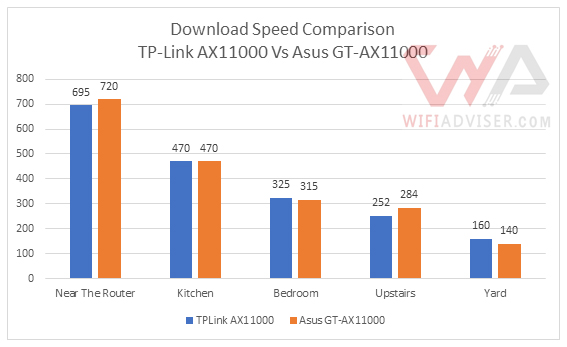

Comparison of Download Speeds for the Asus GT-AX11000 vs TPLink Archer AX110000 on the 5GHz Band
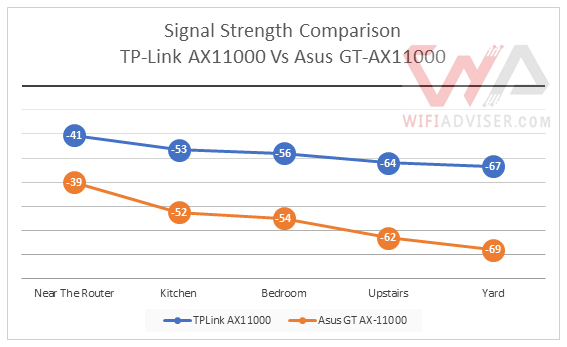

Comparing the Signal Strengths of the Asus GT-AX11000 and TPLink AX110000 in the 5GHz Band
HomeCare: Your Digital Guardian, Tested and Approved
Imagine a network knight keeping your house safe from internet dangers, controlling your children’s screen time, and making sure your favorite games function properly. I tested it on a TPLink Archer AX11000 to see if it lives up to the promises. That’s the beauty of TP-Link HomeCare.
Antivirus: A Protector for All Devices
Do you believe antivirus software is only for laptops and desktop computers? Think again! Every device linked to the network, including those without integrated security, is protected by HomeCare, which serves as a silent guardian. Suspicious activity is identified, malicious websites are stopped before they can do any damage, and infected devices are automatically quarantined. It protects my data and keeps the bad people out of my network, much like an invisible force field.
Parental Controls: managing Curious Clicks
My children’s profiles were easy to set up. The user-friendly software made it simple for me to establish time limits and ban objectionable information. No more dubious internet visits or late-night YouTube binges! I was able to see exactly where their online escapades led them thanks to the Insights tool, which opened my eyes. I felt so much more at ease knowing they were responsible and safe.
Quality of Service: No More Laggy Battles (or Movies!)
Do you recall those annoying times when your online game lags during the final battle or your movie buffers in the middle of a scene? No more! My secret weapon is HomeCare’s QoS. I make sure everyone gets the bandwidth they require by prioritizing streaming, gaming, or video chatting with a few affects. Everyone receives a fair share of the internet pie, eliminating family arguments about internet speed.
My Experience in the Real World: Testing the Use of HomeCare
I experimented with “HomeCare“ for weeks. While I streamed movies and battled online without experiencing any latency, my children had access to age-appropriate content and continuous online learning. It was simple to prioritize devices and set up parental controls, and the app design made handling everything easy. Above all, knowing that my network was protected from internet threats gave me a sense of security. Read More : How to Secure WiFi Network
Conclusion
Our team at WiFiAdviser is impressed after testing the TPLink AX11000 on everything from raw speed to security capabilities. With its tri-band architecture and strong processing, it eliminates lag and provides outstanding performance. Whether you’re a serious contender or a recreational gamer, the AX11000 offers the speed and stability you need.
However, raw power is not the only factor. With its cutting-edge security capabilities, the Archer AX11000 protects your devices and network, allowing you to play games with confidence. We firmly suggest this router to any gamer looking for a smooth and safe online experience because it received an almost flawless score 9.5 of 10.


